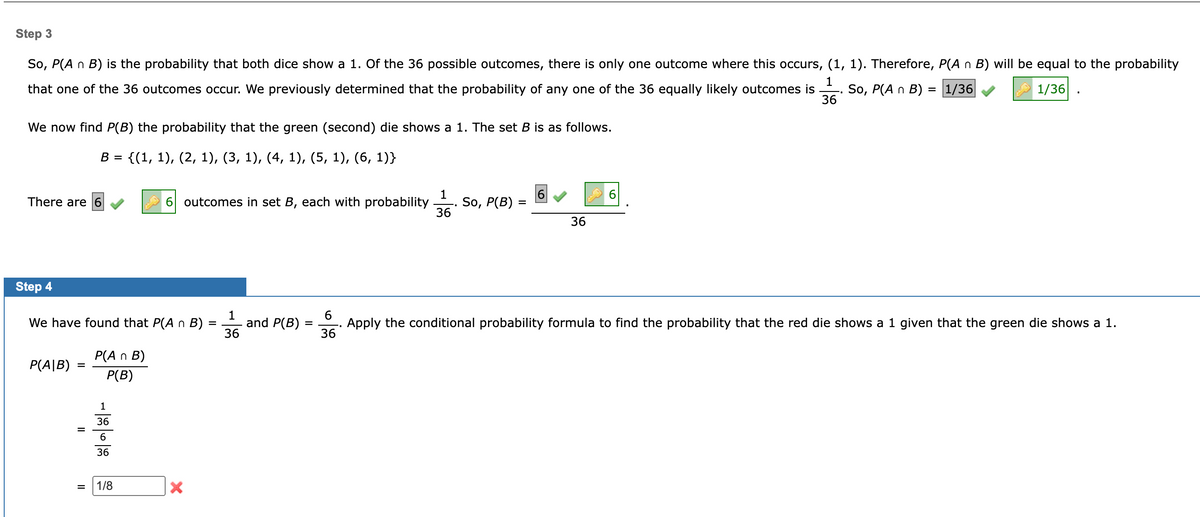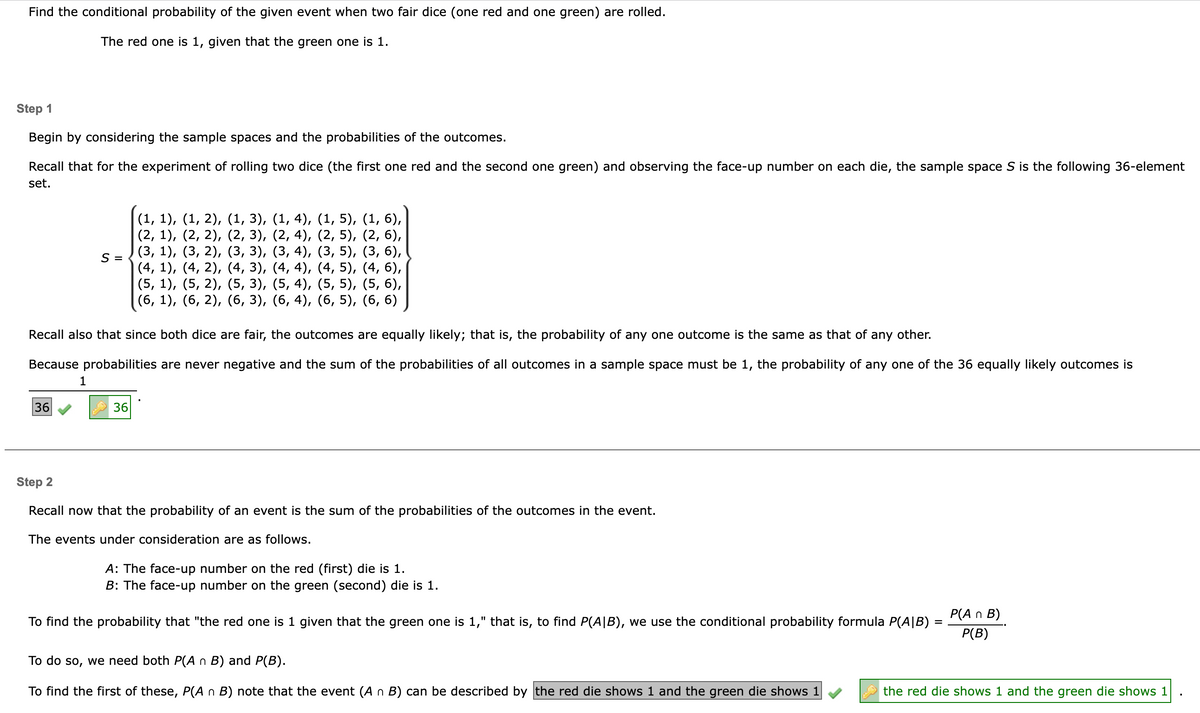Find the conditional probability of the given event when two fair dice (one red and one green) are rolled. The red one is 1, given that the green one is 1.
Find the conditional probability of the given event when two fair dice (one red and one green) are rolled. The red one is 1, given that the green one is 1.
Advanced Engineering Mathematics
10th Edition
ISBN:9780470458365
Author:Erwin Kreyszig
Publisher:Erwin Kreyszig
Chapter2: Second-order Linear Odes
Section: Chapter Questions
Problem 1RQ
Related questions
Question

Transcribed Image Text:Step 3
So, P(A n B) is the probability that both dice show a 1. Of the 36 possible outcomes, there is only one outcome where this occurs, (1, 1). Therefore, P(A n B) will be equal to the probability
1
that one of the 36 outcomes occur. We previously determined that the probability of any one of the 36 equally likely outcomes is So, P(A n B) = 1/36
1/36
36
We now find P(B) the probability that the green (second) die shows a 1. The set B is as follows.
B {(1, 1), (2, 1), (3, 1), (4, 1), (5, 1), (6, 1)}
There are 6
Step 4
1
We have found that P(A n B) = and P(B)
36
P(AIB)
=
=
||
P(An B)
P(B)
1
36
6
36
1/8
6 outcomes in set B, each with probability So, P(B)
X
=
1
36
6
36
=
36
Apply the conditional probability formula to find the probability that the red die shows a 1 given that the green die shows a 1.

Transcribed Image Text:Find the conditional probability of the given event when two fair dice (one red and one green) are rolled.
The red one is 1, given that the green one is 1.
Step 1
Begin by considering the sample spaces and the probabilities of the outcomes.
Recall that for the experiment of rolling two dice (the first one red and the second one green) and observing the face-up number on each die, the sample space S is the following 36-element
set.
36
S =
Recall also that since both dice are fair, the outcomes are equally likely; that is, the probability of any one outcome is the same as that of any other.
Because probabilities are never negative and the sum of the probabilities of all outcomes in a sample space must be 1, the probability of any one of the 36 equally likely outcomes is
1
(1, 1), (1, 2), (1, 3), (1, 4), (1, 5), (1, 6),
(2, 1), (2, 2), (2, 3),
(2, 4), (2, 5), (2, 6),
(3, 4),
(3, 5), (3, 6),
(3, 1), (3, 2), (3, 3),
(4, 1), (4, 2), (4, 3),
(5, 1), (5, 2), (5, 3),
(4, 4), (4, 5),
(4, 6),
(5, 4), (5, 5), (5, 6),
(6, 4), (6, 5), (6, 6)
(6, 1), (6, 2), (6, 3),
36
Step 2
Recall now that the probability of an event is the sum of the probabilities of the outcomes in the event.
The events under consideration are as follows.
A: The face-up number on the red (first) die is 1.
B: The face-up number on the green (second) die is 1.
To find the probability that "the red one is 1 given that the green one is 1," that is, to find P(AIB), we use the conditional probability formula P(AIB)
To do so, we need both P(A n B) and P(B).
To find the first of these, P(A n B) note that the event (A n B) can be described by the red die shows 1 and the green die shows 1
=
P(A n B)
P(B)
the red die shows 1 and the green die shows 1
Expert Solution
This question has been solved!
Explore an expertly crafted, step-by-step solution for a thorough understanding of key concepts.
Step by step
Solved in 2 steps with 2 images

Recommended textbooks for you

Advanced Engineering Mathematics
Advanced Math
ISBN:
9780470458365
Author:
Erwin Kreyszig
Publisher:
Wiley, John & Sons, Incorporated

Numerical Methods for Engineers
Advanced Math
ISBN:
9780073397924
Author:
Steven C. Chapra Dr., Raymond P. Canale
Publisher:
McGraw-Hill Education

Introductory Mathematics for Engineering Applicat…
Advanced Math
ISBN:
9781118141809
Author:
Nathan Klingbeil
Publisher:
WILEY

Advanced Engineering Mathematics
Advanced Math
ISBN:
9780470458365
Author:
Erwin Kreyszig
Publisher:
Wiley, John & Sons, Incorporated

Numerical Methods for Engineers
Advanced Math
ISBN:
9780073397924
Author:
Steven C. Chapra Dr., Raymond P. Canale
Publisher:
McGraw-Hill Education

Introductory Mathematics for Engineering Applicat…
Advanced Math
ISBN:
9781118141809
Author:
Nathan Klingbeil
Publisher:
WILEY

Mathematics For Machine Technology
Advanced Math
ISBN:
9781337798310
Author:
Peterson, John.
Publisher:
Cengage Learning,

